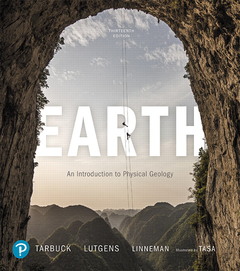Description
Earth (13th Ed.)
An Introduction to Physical Geology
Authors: Tarbuck Edward, Lutgens Frederick, Tasa Dennis, Linneman Scott
Language: English
Subject for Earth:
185.59 €
In Print (Delivery period: 14 days).
Add to cart784 p. · Paperback
Description
/li>Contents
/li>Biography
/li>Comment
/li>
For all introductory physical geology courses.
Bringing Earth to life
Earth: An Introduction to Physical Geology, 13th Edition, is a leading text in the field, characterized by no-nonsense, student-friendly writing, excellent illustrations, and a modular learning path driven by learning objectives. The new editionis the first to integrate 3D technology that brings geology to life. This edition features significant content updates, a new Geology in the News feature to promote student engagement, and a new Data Analysis feature to help develop students? critical thinking skills.
Also available as a Pearson eText or packaged with Mastering Geology
Pearson eText is a simple-to-use, mobile-optimized, personalized reading experience available within Mastering Geology. It lets students highlight, take notes, and review key vocabulary all in one place ? even when offline. Seamlessly integrated videos and other rich media engage students and give them access to the help they need, when they need it. Educators can easily share their own notes with students so they see the connection between their eText and what they learn in class.
Mastering? is the teaching and learning platform that empowers you to reach every student. By combining trusted author content with digital tools developed to engage students and emulate the office-hour experience, Mastering personalizes learning and improves results for each student. Built for, and directly tied to the text, Mastering Geology enables students to get hands on with tools and activities to practice, learn, and apply geology outside of the classroom.
Note: You are purchasing a standalone product; Mastering Geology does not come packaged with this content. Students, ask your instructor for the correct package ISBN and Course ID. Instructors, contact your Pearson representative for more information.
If your instructor has assigned Pearson eText as your main course material, search for:
? 0135586097 / 9780135586099 Pearson eText Earth: An Introduction to Physical Geology -- Access Card, 13/e
OR
? 0135729629 / 9780135729625 Pearson eText Earth: An Introduction to Physical Geology, 13/e -- Instant Access
If you would like to purchase both the physical text and Mastering Geology search for:
0135191122 / 9780135191125 Earth: An Introduction to Physical Geology Plus Mastering Geology with Pearson eText -- Access Card Package
Package consists of:
- 0135188318 / 9780135188316 Earth: An Introduction to Physical Geology
- 0135188660 / 9780135188668 Mastering Geology with Pearson eText -- ValuePack Access Card -- for Earth: An Introduction to Physical Geology
- An Introduction to Geology
- Plate Tectonics: A Scientific Revolution Unfolds
- Matter and Minerals
- Igneous Rocks and Intrusive Activity
- Volcanoes and Volcanic Hazards
- Weathering and Soils
- Sedimentary Rocks
- Metamorphism and Metamorphic Rocks
- Geologic Time
- Crustal Deformation
- Earthquakes and Earthquake Hazards
- Earth's Interior
- Origin and Evolution of the Ocean Floor
- Mountain Building
- Mass Movement: The Work of Gravity
- Running Water
- Groundwater
- Glaciers and Glaciation
- Deserts and Winds
- Shorelines
- Global Climate Change
- Earth's Evolution Through Geologic Time
- Energy and Mineral Resources
- Touring Our Solar System
APPENDIX
- Metric and English Units Compared
About our authors
Fred Lutgens and Ed Tarbuck have been good friends and colleagues since 1970. Between them, they have more than 57 years of experience teaching geology to undergraduates, and both have been recognized with awards as excellent and inspiring professors. They share a special interest in introducing geology to beginning students and a belief in the value of field experiences for students of all levels.
Lutgens and Tarbuck published their first college text, Earth Science, in 1976. That book, winner of the McGuffy Award from the Text and Academic Authors Association, is now going into its 15th edition. In 1983, as the 1st edition of Earth was being prepared, gifted geology illustrator Dennis Tasa joined the author team. Since then the three have collaborated on more than 20 projects. Not only do Tarbuck, Lutgens, and Tasa work well together creatively, they also enjoy spending time in the Sangre de Cristo Mountains near Tasa's New Mexico studio.
Tarbuck enjoys downhill skiing in Colorado, fly fishing near his childhood home in Northern Minnesota, and spending time in the Cascades. Lutgens is an avid runner, and when he can make the time, truly enjoys hiking the canyons of the Colorado Plateau. Although Lutgens and Tarbuck think alike on many issues, they don't agree on everything. Lutgens is devoted to jazz and classical music, whereas Tarbuck prefers pop artists or a good country station.
Dr. Scott Linneman is a Professor of Geology and Science Education at Western Washington University in Bellingham WA. Having earned a B.A. from Carleton College in Minnesota, and a Ph.D. from the University of Wyoming, Scott's research spans the fields of geomorphology as well as igneous petrology and volcanology. In 2011, he was named the Higher Education Science Teacher of the Year for Washington by the Washington Science Teachers Association,
Hallmark features of this title
- The Modular learning path focuses students on important ideas and assesses progress at frequent intervals.
- Focus on Concepts start each chapter with learning objectives that correspond to each chapter major section and provide a clear path to the content.
- Concept Checks conclude each chapter section with questions tied to learning objective, allowing students to monitor their grasp of key facts and ideas.
- End-of-Chapter Concepts in Review sections provide a concise chapter overview.
- Give It Some Thought questions ask students to analyze, synthesize and think critically about geology.
- A bold, magazine-style graphic design helps to make the text approachable and readable.
- Concepts in Review provides a structured and highly visual review of the chapter.

